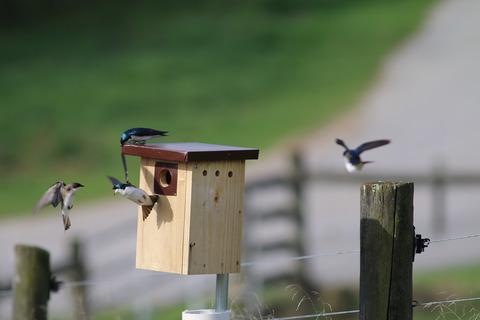当前位置:
X-MOL 学术
›
Ecol. Evol.
›
论文详情
Our official English website, www.x-mol.net, welcomes your
feedback! (Note: you will need to create a separate account there.)
Assessing age, breeding stage, and mating activity as drivers of variation in the reproductive microbiome of female tree swallows
Ecology and Evolution ( IF 2.3 ) Pub Date : 2021-07-29 , DOI: 10.1002/ece3.7929 Jessica Hernandez 1 , Catherine Hucul 1 , Emily Reasor 1 , Taryn Smith 1 , Joel W McGlothlin 1 , David C Haak 2 , Lisa K Belden 1 , Ignacio T Moore 1
Ecology and Evolution ( IF 2.3 ) Pub Date : 2021-07-29 , DOI: 10.1002/ece3.7929 Jessica Hernandez 1 , Catherine Hucul 1 , Emily Reasor 1 , Taryn Smith 1 , Joel W McGlothlin 1 , David C Haak 2 , Lisa K Belden 1 , Ignacio T Moore 1
Affiliation

|
Sexually transmitted microbes are hypothesized to influence the evolution of reproductive strategies. Though frequently discussed in this context, our understanding of the reproductive microbiome is quite nascent. Indeed, testing this hypothesis first requires establishing a baseline understanding of the temporal dynamics of the reproductive microbiome and of how individual variation in reproductive behavior and age influence the assembly and maintenance of the reproductive microbiome as a whole. Here, we ask how mating activity, breeding stage, and age influence the reproductive microbiome. We use observational and experimental approaches to explain variation in the cloacal microbiome of free-living, female tree swallows (Tachycineta bicolor). Using microsatellite-based parentage analyses, we determined the number of sires per brood (a proxy for female mating activity). We experimentally increased female sexual activity by administering exogenous 17ß-estradiol. Lastly, we used bacterial 16S rRNA amplicon sequencing to characterize the cloacal microbiome. Neither the number of sires per brood nor the increased sexual activity of females significantly influenced female cloacal microbiome richness or community structure. Female age, however, was positively correlated with cloacal microbiome richness and influenced overall community structure. A hypothesis to explain these patterns is that the effect of sexual activity and the number of mates on variation in the cloacal microbiome manifests over an individual's lifetime. Additionally, we found that cloacal microbiome alpha diversity (Shannon Index, Faith's phylogenetic distance) decreased and community structure shifted between breeding stages. This is one of few studies to document within-individual changes and age-related differences in the cloacal microbiome across successive breeding stages. More broadly, our results contribute to our understanding of the role that host life history and behavior play in shaping the cloacal microbiomes of wild birds.
中文翻译:

评估年龄、繁殖阶段和交配活动作为雌性树燕生殖微生物组变异的驱动因素
假设性传播微生物会影响生殖策略的进化。尽管在这方面经常被讨论,但我们对生殖微生物组的理解还处于初级阶段。事实上,检验这一假设首先需要对生殖微生物组的时间动态以及生殖行为和年龄的个体差异如何影响整个生殖微生物组的组装和维持建立基线了解。在这里,我们询问交配活动、繁殖阶段和年龄如何影响生殖微生物组。我们使用观察和实验方法来解释自由生活的雌性树燕( Tachycineta bicolor )泄殖腔微生物组的变化。使用基于微卫星的亲子分析,我们确定了每窝雄性的数量(雌性交配活动的代表)。我们通过给予外源性 17β-雌二醇来实验性地增加女性性活动。最后,我们使用细菌 16S rRNA 扩增子测序来表征泄殖腔微生物组。每窝雄性的数量和雌性性活动的增加都不会显着影响雌性泄殖腔微生物组的丰富度或群落结构。然而,女性年龄与泄殖腔微生物组丰富度呈正相关,并影响整体群落结构。解释这些模式的一个假设是,性活动和交配数量对泄殖腔微生物群变化的影响会在个体的一生中显现出来。此外,我们发现泄殖腔微生物组α多样性(香农指数,费思的系统发育距离)下降,并且在繁殖阶段之间群落结构发生变化。 这是记录连续繁殖阶段泄殖腔微生物组的个体内部变化和年龄相关差异的少数研究之一。更广泛地说,我们的结果有助于我们了解宿主的生活史和行为在塑造野生鸟类泄殖腔微生物群中所起的作用。
更新日期:2021-08-16
中文翻译:

评估年龄、繁殖阶段和交配活动作为雌性树燕生殖微生物组变异的驱动因素
假设性传播微生物会影响生殖策略的进化。尽管在这方面经常被讨论,但我们对生殖微生物组的理解还处于初级阶段。事实上,检验这一假设首先需要对生殖微生物组的时间动态以及生殖行为和年龄的个体差异如何影响整个生殖微生物组的组装和维持建立基线了解。在这里,我们询问交配活动、繁殖阶段和年龄如何影响生殖微生物组。我们使用观察和实验方法来解释自由生活的雌性树燕( Tachycineta bicolor )泄殖腔微生物组的变化。使用基于微卫星的亲子分析,我们确定了每窝雄性的数量(雌性交配活动的代表)。我们通过给予外源性 17β-雌二醇来实验性地增加女性性活动。最后,我们使用细菌 16S rRNA 扩增子测序来表征泄殖腔微生物组。每窝雄性的数量和雌性性活动的增加都不会显着影响雌性泄殖腔微生物组的丰富度或群落结构。然而,女性年龄与泄殖腔微生物组丰富度呈正相关,并影响整体群落结构。解释这些模式的一个假设是,性活动和交配数量对泄殖腔微生物群变化的影响会在个体的一生中显现出来。此外,我们发现泄殖腔微生物组α多样性(香农指数,费思的系统发育距离)下降,并且在繁殖阶段之间群落结构发生变化。 这是记录连续繁殖阶段泄殖腔微生物组的个体内部变化和年龄相关差异的少数研究之一。更广泛地说,我们的结果有助于我们了解宿主的生活史和行为在塑造野生鸟类泄殖腔微生物群中所起的作用。











































 京公网安备 11010802027423号
京公网安备 11010802027423号